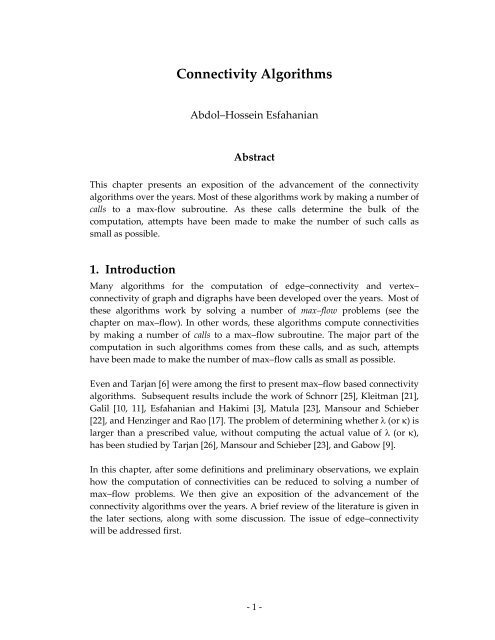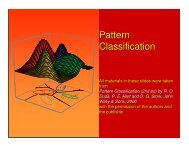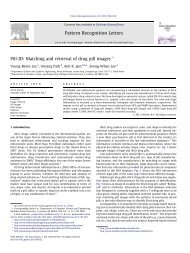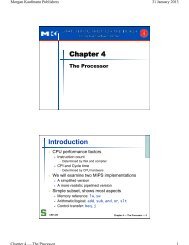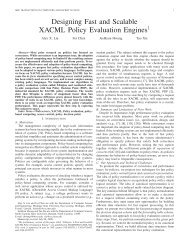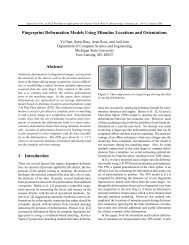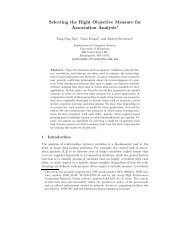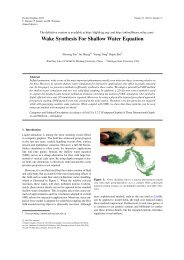Graph Connectivities
Graph Connectivities
Graph Connectivities
Create successful ePaper yourself
Turn your PDF publications into a flip-book with our unique Google optimized e-Paper software.
Connectivity AlgorithmsAbdol–Hossein EsfahanianAbstractThis chapter presents an exposition of the advancement of the connectivityalgorithms over the years. Most of these algorithms work by making a number ofcalls to a max‐flow subroutine. As these calls determine the bulk of thecomputation, attempts have been made to make the number of such calls assmall as possible.1. IntroductionMany algorithms for the computation of edge–connectivity and vertex–connectivity of graph and digraphs have been developed over the years. Most ofthese algorithms work by solving a number of max–flow problems (see thechapter on max–flow). In other words, these algorithms compute connectivitiesby making a number of calls to a max–flow subroutine. The major part of thecomputation in such algorithms comes from these calls, and as such, attemptshave been made to make the number of max–flow calls as small as possible.Even and Tarjan [6] were among the first to present max–flow based connectivityalgorithms. Subsequent results include the work of Schnorr [25], Kleitman [21],Galil [10, 11], Esfahanian and Hakimi [3], Matula [23], Mansour and Schieber[22], and Henzinger and Rao [17]. The problem of determining whether (or ) islarger than a prescribed value, without computing the actual value of (or ),has been studied by Tarjan [26], Mansour and Schieber [23], and Gabow [9].In this chapter, after some definitions and preliminary observations, we explainhow the computation of connectivities can be reduced to solving a number ofmax–flow problems. We then give an exposition of the advancement of theconnectivity algorithms over the years. A brief review of the literature is given inthe later sections, along with some discussion. The issue of edge–connectivitywill be addressed first.‐ 1 ‐
1. If G is a graph, replace each edge xy with arcs (x, y) and (y, x).2. Assign v as the source vertex and w as the sink vertex.3. Assign the capacity of each arc to 1, and call the resulting network H.4. Find a max–flow function f in H.5. Set (v, w) equal to the total flow of f. Stop.As Even showed, the time complexity of the above algorithm is O(nm) [5].Provided that we have access to a max–flow software, we can use the abovealgorithm as a subroutine, and compute all possible (v, w), take the minimum ofthese quantities, and subsequently compute . For a graph with n vertices, thereare n(n–1)/2 unordered (v, w) to compute, whereas there are n(n–1) ordered (v,w) to compute in case of a digraph. It turns out, however, that to determine ,there are far fewer (v, w) that we need to compute.Consider the following abstraction of a graph G, and an arbitrary minimumedge–cut S in G (to eliminate the obvious cases in the following discussion, wewill assume G is a connected nontrivial graph).LR = V – LSFigure 1: <strong>Graph</strong> G = (V,E ) and a minimum edge‐cut S.In Figure 1, L and R refer to the vertex sets of the two components of G – S, andwe will refer to them as the “sides” of S. The key observation here is that for anyvertex v in one side of S (either in L or in R ) and for any vertex w in the otherside (either in R or in L ), we have (v, w) = (G). Thus (G) could be determinedif we had an “oracle” as follows:1. Select an arbitrary vertex v in some side of S.2. Using the “oracle”, identify a vertex w on the other side of S.3. Computer (v, w) using Algorithm 1. Assign (G) (v, w). Stop.Even and Tarjan [6] and Schnorr [25] observed that, once v is selected in theabove algorithm, vertex w could be identified to within a set X = V(G) – {v}, whichled to the following algorithm for computing .‐ 3 ‐
Algorithm 2:Input: A connected non–trivial graph G = (V,E).Output: Value of (G).1. Select an arbitrary vertex v V, and let X = V – {v}.2. Using Algorithm 1, compute (v, w) for every w X.3. Assign (G) min{ (v, w) w X }. Stop.The above algorithm reduces the number of computations of (v, w) from n(n–1)/2, as discussed earlier, to n – 1, which is a significant reduction. If you keepstaring at Figure 1, you notice that the above algorithm would correctly compute(G) if set V in Step 1 is replaced by any set Y that contains vertices both from Land from R. Such a set Y will be called a –covering of G. Of course, the smaller Y,the fewer calls to the max–flow subroutine. This observation and the followinglemma led to new algorithms for computing (G).It is well known that for any graph G we have (G) (G). What happens to thesize of L and R as depicted in Figure 1, when (G) < (G)? The significant of thisquestion will become clear later. The following lemma (see [3]) answers thatquestion. Keep Figure 1 in mind!Lemma 1:Let L and R be defined as above. If (G) < (G) then L > and R > .Proof: Let L = {v1, v2, … , vl}. We know thatdeg(v1) + deg(v2) + + deg(vl) l.We also know thatdeg(v1) + deg(v2) + + deg(vl) = 2 E( L ) + Swhere E( L ) refers to the edge set of the graph induced by the vertex set L. Theright–hand side of the above equality will be maximum when L induces acomplete graph, that is, each deg(vi) = l ‐1 . Thus we have l deg(v1) + deg(v2) + + deg(vl) l (l – 1) + S.Since we are assuming that S= (G) < (G), we have l < l (l – 1) + , whichimplies l > , if (l – 1) > 0. However, we know L contains more than one vertexbecause otherwise (G) cannot be less than (G). A similar reasoning establishesthat R > . ■Before discussing an application of this lemma the following observations are inorder.‐ 4 ‐
2. Select a vertex v and assign V(T) {v} N(v), and E(T) E(T) I(v) .3. Select a leaf w in T such thatN(w) (V(G) – V(T)) N(r) (V(G) – V(T))for all leaves r in T.4. For each neighbour u of w not in T, that is, u N(w) (V(G) – V(T)), addvertex u to V(T), and edge wu to E(T).5. If E(T) < V(T) – 1 go to Step 3. Otherwise Stop.The essence of the above algorithm is to “grow” the partial formation of H from aleaf that contributes the most to the “growth” of T. This algorithm tends togenerate spanning trees with a large number of leaves. The property of Tdiscussed above suggests the following algorithm for computing .Algorithm 5:Input: A connected non–trivial graph G = (V,E).Output: Value of (G).1. Use Algorithm 4 to generate a spanning tree T of G. Let Y be set of allnon–leaves of T. Moreover, let X be the smaller of the two sets Y and V –Y.2. Select an arbitrary vertex v X, and let Z = X – {v}.3. Using Algorithm 1, compute (v, w) for every w Z.4. Assign c min{ (v, w) w Z }.5. Assign (G) min{c , (G)}. Stop.The correctness of this algorithm should be evident from the aforementioneddiscussion. Furthermore, since X n/2, it makes no more that n/2 calls toAlgorithm 1.Matula [23] further improved upon Algorithm 5 by making use of Lemma 1 anddominating sets. In a graph G = (V,E), a set D V is called a dominating set if forany vertex v V, either v D or v is incident in G to a vertex in D. The followingresult can be easily deduced from Lemma 1.Corollary 2.Let G be a graph having (G) < (G), and let S be a minimum edge‐cut with L and R asits sides. If D is a dominating set in G, then D is a –covering of G. ■Corollary 2 suggests the following algorithm for computing (G).Algorithm 6.Input: A connected non–trivial graph G = (V,E).Output: Value of (G).1. Select a dominating set D of G.‐ 6 ‐
2. Select an arbitrary vertex v D, and let X = D – {v}.3. Using Algorithm 1, compute (v, w) for every w X.4. Assign c min{ (v, w) w X }.5. Assign (G) min{ c , (G) }. Stop.Clearly this algorithm determines (G) correctly. Furthermore, the smaller the setD, the fewer calls to Algorithm 1. While finding a smallest dominating set is NP–hard [13], finding some dominating set is easy. The next algorithm provides away of for generating a “small” dominating set. Recall that for graph G = (V,E),we define the neighbourhood set N(X) of a vertex set X V as:Algorithm 7:N(X) = { v V – X v is adjacent in G to some vertex in X }.Input: A connected non–trivial graph G = (V,E).Output: A dominating set D1. Select a vertex v V(D), and let D = {v}.2. If V – (D N(D)) = , then Stop.3. Select a vertex w V – (D N(D)), and assign D D {w}. Go to Step 2.By using a dominating set D as produced by this algorithm, and amortizing thecost of computing (v, w) for the vertices in D, Matula [23] was able to bringdown the overall complexity of computing (G) to O(nm). His algorithm is thefastest known algorithm for determining (G).3. Computing Arc–ConnectivityWe now turn our attention to computing arc‐connectivity of digraphs. Considerthe following abstraction of a digraph D, and an arbitrary minimum arc–cut S inD (again to eliminate the obvious cases in the following discussion, we assume Dis a weakly connected nontrivial digraph).SLR = V – LFigure 2: Digraph D = (V,E ) and a minimum arc‐cut S.‐ 7 ‐
The vertex‐connectivity (G) of a graph G = (V,E) is the least cardinality Sof avertex set S V such that G – S is either disconnected or trivial. Such a set S iscalled a minimum vertex‐cut. We will first explain how the computation of (G)reduces to solving a number of max‐flow problems.Let v and w be two vertices in graph G = (V,E). If vw E, we define (v, w) as theleast number of vertices, chosen from V – {v, w}, whose deletion from G woulddestroy every path between v and w, and if vw E then let (v, w) = n – 1, wheren is the order of the graph. Clearly (G) can be expressed in terms of (v, w) asfollows:(G) = min{ (v, w) unordered pair v , w in G }. (3)It has been shown that (v, w) for a pair of non‐adjacent vertices v and w can bedetermined by solving a max‐flow problem in a particular network, as describedbelow [5]:Algorithm 9:Input: <strong>Graph</strong> G = (V,E), and a pair of non‐adjacent vertices v and w.Output: Value for (v, w).1. Replace each edge xy E with arcs (x, y) and (y, x), and call the resultingdigraph D.2. For each vertex u other than v and w in G, replace u with two new verticesu1 and u2, and then add the new arc (u1, u2). Connect all the arcs that werecoming to u in G to u1, and similarly, connect all the arcs that were goingout of u in G to u2 in D.3. Assign v as the source vertex and w as the sink vertex.4. Assign the capacity of each arc to 1, and call the resulting network H.5. Find a max–flow function f in H.6. Set (v, w) equal to the total flow of f. Stop.The time complexity of the above algorithm is O(mn 2/3 ), see [5]. Provided that onehas access to a max‐flow software, this algorithm can be used as a subroutine,and compute (v, w) for all non‐adjacent vertices v and w. This would requiren(n‐1)/2 – m calls to Algorithm 8. However, it turns out that there are algorithmsfor computing that would require fewer calls to max‐flow.Consider the following abstraction of a graph and an arbitrary minimum vertexcutS in G (to eliminate obvious cases in the following discussion, we will assumethat G is a connected nontrivial graph, and also that G is not complete.)‐ 9 ‐
complete graph).L S R = V – (L S)Figure 3: <strong>Graph</strong> G = (V,E) and a minimum vertex‐cut SIn this abstraction, L is the vertex set of one of the components of G – S, and R isunion of the vertex sets of all the other components of G – S. Clearly for a vertexv L and a vertex w R, we have (v, w) = (G), and thus one might be temptedto use the same idea as in Algorithm 2, and select an arbitrary vertex v andcomputemin{ (v, w) w V – {v}, and w is not adjacent to v in G }.and assign it to (G). However, for this computation to be true, G must have aminimum vertex‐cut that does not contain v. Recall that in any graph G, we have(G) (G). Thus, if we take a set X V, with X> (G), then for every minimumvertex‐cut S in G, there exists at least one vertex of X that is not in S, and thus can be computed by first finding, for each vertex v X,v= min{ (v, w) w V – {v}, and w is not adjacent to v in G }and then setting(G) = min{v v X }.Even and Tarjan [6] observed that if we keep track of the minimum value of (v,w) as they are computed, then a set X of order + 1 will suffice. Here is theiralgorithm.Algorithm 10:Input: <strong>Graph</strong> G = (V,E)Output: Value for (G).1. Assign i 1, N n – 1, and let V = {v1, v2, … , vn}.2. For each j, j = i + 1, i + 2, …, n,a. If i > N go to Step 4.‐ 10 ‐
. If vi and vj are not adjacent in G, then compute (vi, vj) usingAlgorithm 9, and assign N min {N, (vi, vj)}. End of For.3. Assign i i + 1, and then go to Step 2.4. Assign (G) N, Stop.This algorithm makes O((n – – 1)) calls to max‐flow. However, the followingobservation of Esfahanian and Hakimi further can reduce the number of calls tomax‐flow for computing .Take an arbitrary vertex v V(G), and consider its situation in Figure 3. If thereis a minimum vertex‐cut S that does not contain v, then we have(G) = min{ (v, w) w V – {v}, and w is not adjacent to v}. (4)On the other hand, if v belongs to every minimum vertex‐cut S, it can be shown[3] that at least two neighbours of v must lie outside S, and in this case we have(G) = min{ (x, y) x , y N(v), and x and y are non‐adjacent}. (5)Not knowing which of the above situations is true for an arbitrary vertex v, bothsituations must be considered. This gives the following algorithm:Algorithm 11:Input: <strong>Graph</strong> G = (V,E)Output: Value for (G).1. Select an arbitrary vertex v of minimum degree.2. Compute k1 = min{ (v, w) w V – {v}, and w is not adjacent to v}.3. Compute k2 = min{ (x, y) x , y N(v), x and y are non‐adjacent }.4. Assign (G) min {k1 , k2}, Stop.This algorithm makes O(n – – 1 + ( – 1)/2) calls to max‐flow. For a furtherrefinement of this algorithm, see [3].5. Concluding RemarksWe have covered some key developments in pursuit of fast algorithms forcomputing connectivities. While all these algorithms were max‐flow based,researchers have tried other methods. For example, Henzinger and Rao [17] havedeveloped a randomised algorithm for the computation of the connectivity.Algorithms have also been developed for deciding whether a graph is l‐edge (orl‐vertex) connected, some of which are max‐flow based some are not. Thefollowing table gives a summary of connectivity related algorithms.‐ 11 ‐
Decision Author(s) Year Complexity CommentsEdge Connectivity = 2 or = 3 Tarjan [26] 1972 O(m + n) uses Depth First Search Even and Tarjan [6] 1975 O(mn min{m 1/2 , n 2/3 }) n calls to max‐flow (digraphs) Schnorr [25] 1979 O(mn) n calls to max‐flow Esfahanian & Hakimi [3] 1984 O(mn) n/2 calls to max‐flow (digraphs) Esfahanian & Hakimi [3] 1984 O(mn) n/2 calls to max‐flow Matula [23] 1987 O(mn) uses dominating sets = k Matula [23] 1987 O(kn 2 ) (digraphs) Mansour & Schieber [22] 1989 O(mn) = k Gabow [9] 1991 O(m+k 2 nlog(n/k)) uses matroidsVertex Connectivity = 2 Tarjan [26] 1972 O(m + n) uses Depth First Search = 3 Hopcroft & Tarjan [18] 1973 O(m + n) uses triconnectedcomponents Even & Trajan [6] 1975 O(((n – – 1)mn 2/3 ) max‐flow based = k Even [4] 1975 O(kn 3 ) max‐flow based Galil [12] 1980 O(min{, n 2/3 }mn) max‐flow based = k Galil [12] 1980 O(min{k, n 1/2 }kmn) max‐flow based Esfahanian & Hakimi [3] 1984 O(( n – – 1 + ( – 1)/2)mn 2/3 ) max‐flow based = 4 Kanevsky &1991 O(n 2 )Ramachandran [20] Henzinger & Rao [17] 1996 O(mnlogn) randomised algorithmTable 1: A chronology of connectivity algorithms‐ 12 ‐
6. References1. M. Becker, W. Degenhardt, J. Doenhardt, S. Hertel, G. Kaninke, and W.Keber, “A probabilistic algorithm for vertex connectivity of graphs,” Inf.Proc. Letters 15 (1982), pp. 135‐136.2. E. A. Dinic, “Algorithm for solution of a problem of maximum flow in anetwork with power estimation,” Soviet Math. Dokl. 11 (1970), pp. 1277‐1280.3. A‐H. Esfahanian and S. L. Hakimi, “On computing the connectivities ofgraphs and digraphs,” NETWORKS, Vol. 14, pp. 355-366, 1984.4. S. Even, “An algorithm for determining whether the connectivity of agraph is at least k,” SIAM Journal of Computing 4 (1975), 393‐396.5. S. Even, <strong>Graph</strong> Algorithms, Computer Science, 1979.6. S. Even and R. E. Tarjan, “Network flow and testing graph connectivity,”SIAM Journal of Computing 4 (1975), pp. 507‐518.7. H. Frank and W. Chou, “Connectivity considerations in the design ofsurvivable networks,” IEEE Transitions on Circuit Theory CT‐17 (1970),pp. 486‐490.8. G. N. Frederickson, “Ambivalent data structures for dynamic 2‐edgeconnectivityand k smallest spanning trees,” Journal of Computing, Vol26 No.2 (1997), pp. 484‐538.9. H. Gabow, “A matroid approach to finding edge connectivity andpacking arborescences,” Journal of Computer and System Science 50(9), pp.259‐275.10. Z. Galil, “Finding the vertex connectivity of graphs,” SIAM Journal ofComputing, 9 (1980), pp. 197‐199.11. Z. Galil and G. F. Italiano, “Reducing edge connectivity to vertexconnectivity,” ACM SIGACT News 22 (1991), pp. 57‐61.12. Z. Galil and G. F. Italiano, “Fully Dynamic Algorithms for 2‐EdgeConnectivity,” SIAM Journal of Computing 21 (1992), pp. 1047‐1069.13. M. R. Garey and D. S. Johnson, Computers and Intractability, A guide to thetheory of NP‐Completeness, Freeman, San Francisco (1979).14. R. E Gomory and T.C. Hu, “Multi‐terminal network flows,” Journal ofSocial and Industrial and applied Mathematics 9 (1961), pp. 551‐570.15. D. Gusfield, “Optimal Mixed <strong>Graph</strong> Augmentation,” SIAM Journal ofComputing 16 (1987), pp. 599‐612.16. M. R. Henzinger and S. Rao, “Faster Vertex Connectivity Algorithms,”Proceedings of the 37th Annual IEEE Symposium on Foundations of ComputerScience, pp. 1‐15.17. M. R. Henzinger, S. Rao and H. N. Gabow, “Computing vertexconnectivity: new bounds from old techniques,” Proc. 37th IEEE F. O. C.S. (1996), pp. 462‐471.‐ 13 ‐
18. J. Hopcroft, R.E. Tarjan, “Dividing a graph into triconnectedcomponents,” SIAM Journal of Computing 2 (1973), pp. 135‐158.19. T. Hsu, Undirected Vertex‐Connectivity Structure and Smallest Four‐Vertex‐Connectivity Augmentation, Nansheng University, Taiwan.20. A. Kanevsky and V. Ramachandran, “Improved algorithms for graphfour connectivity,” J. Comp. Syst. Sc. 42 (1991), pp. 288‐306.21. D. J. Kleitman, “Methods for investigating connectivity of large graphs,”IEEE Trans. Circuit Theory 16 (1969), pp. 232‐233.22. Y. Mansour and B. Schieber, “Finding the edge connectivity of directedgraphs,” Journal of Algorithms 10 (1989), pp. 76‐85.23. D. W. Matula, “Determining edge connectivity in O(mn),” Proceedings of28th Symp. on Foundations of Computer Science, (1987), pp. 249‐251.24. H. Nagamochi and T. Ibaraki, “Computing edge connectivity inmultigraphs and capacitated graphs,” SIAM J. Disc Math 5 (1992), pp. 54‐66.25. C. P. Schnorr, “Bottlenecks and edge connectivity in unsymmetricalnetworks,” SIAM Journal of Computing 8 (1979), 265‐274.26. R. E. Tarjan, “Depth first search and linear graph algorithms,” SIAMJournal of Computing 1 (1972), pp. 146‐160.‐ 14 ‐


